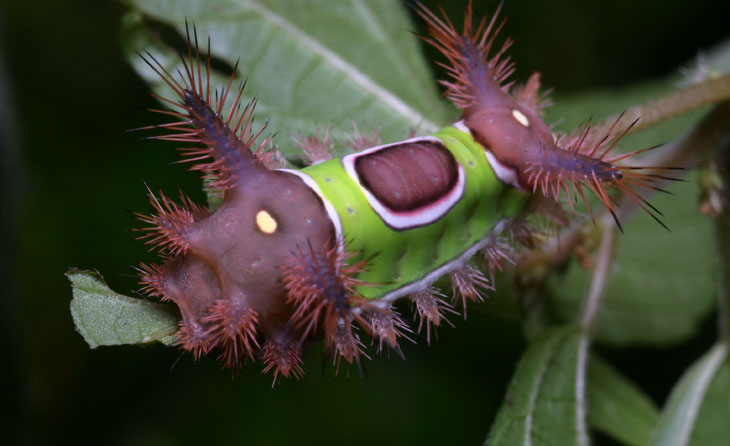
My one and only encounter with this species was just under 11 years ago, and while I wouldn’t mind seeing it again, I’d prefer not to find it the way that I did. This is the larva of a saddleback caterpillar moth (Sibine stimulea,) and those contrasting colors are there for a reason – somewhat self-defeating given that the species likes being on the undersides of leaves in deeper foliage. All those spikes do indeed sting with contact, which is what the memorable color scheme is intended to convey – nothing debilitating, just mildly irritating, a little like a bee sting but not as strong.
I actually had a saga with the species, that began when I discovered one sporting some new ‘appendages.’

There is a class of parasitic wasp, the Braconids, that lay their eggs within the larva of other species, or occasionally in the eggs of such, which then hatch out and feed on the living host larva until they spin their cocoons on the outer surface, eventually emerging from those as flying adults. This does the caterpillar no good at all, but it does not kill them as quickly as you might think, either.
Now we need a little scale here. The caterpillar itself is only 18mm in body length, and the cocoons are 2.5mm – from which an adult wasp will emerge. Yes, they’re tiny wasps, ones that you would barely notice anywhere. But having such a specimen close at hand, I decided I’d attempt to catch the new adults popping free. This was a long-drawn out story that you can find here – suffice to say, it was not one that would encourage anyone to take this up for a living.
Nowadays, I’d endeavor to photograph the eyes and mouth of the species, and I’m not even sure which end is which in these photos. Nor am I sure that, if I tried again to catch the emergence of the parasitic wasps, that I’d do better this time – I can think of nothing to improve my chances, no skills that I’d picked up in the interim. Save for staying out of the sun while waiting.



















































